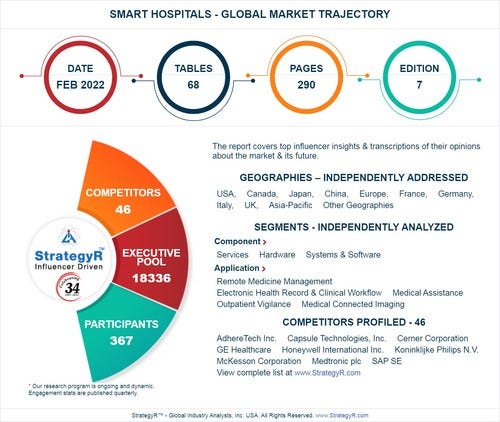Global Industry Analysts, Inc.
Mar 10, 2022
SAN FRANCISCO, March 10, 2022 /PRNewswire/ — A new market study published by Global Industry Analysts Inc., (GIA) the premier market research company, today released its report titled “Smart Hospitals — Global Market Trajectory & Analytics”.
The exponential growth of COVID-19 cases globally has resulted in tremendous burden on hospitals and medical staff.
The situation has prompted various healthcare facilities to rely on artificial intelligence (AI) based sensors for supporting triage in effective manner.
The scenario has also led various companies to leverage AI for developing contactless infrared sensor devices for identifying people with a fever in crowds.
These devices are being increasingly deployed by hospitals for replacing manual screening options to reduce unnecessary exposure of the medical staff to COVID-19 patients.
Various hospitals have implemented AI systems for intercepting individuals with specific COVID-19 symptoms among visiting patients.
The technology relies on cameras deployed at entrances for conducting facial thermal scans and identifying infected patients on the basis of specific signs such as discoloration and sweat.
In addition to screening, the AI technology is used for monitoring patient symptoms, offering decision support related to CT scans and automating hospital operations.
Certain healthcare facilities have also deployed AI-powered robots that can deal with patients and offer minor treatments.
Smart robots intended to deliver foods or medicines to patients reduce physician exposure to infected people.
The report presents fresh perspectives on opportunities and challenges in a significantly transformed post COVID-19 marketplace.
Global Smart Hospitals Market to Reach $111.2 Billion by 2026
Smart hospitals refer to those hospital set-ups that are redesigned, optimized and though not necessarily but may establish new clinical processes and management systems and sometimes even new infrastructure, all of which enabled by digitized networking infrastructure.
Digitization helps by interconnecting all hospital assets, helping smart hospitals achieve greater operational efficiency and experience, and deliver improved patient care.
The smart set-up adds three important elements in the form of data, access and insight to hospitals that helps enhance the quality of care.
With artificial intelligence, data collection and automation deeply ingrained in new smart hospital set-ups, almost everyone including physicians, nursing staff, support staff and patients stand to gain.
Smart hospitals require continued team work where physicians, nursing staff and management need to work together to swiftly detect any potential problems so that relevant solutions are quickly identified, piloted and implemented.
This would ensure clinical processes, care quality, patient experience remain uncompromised, while the hospital reaps optimal operational efficiency and keeps cost under control.
Smart hospitals are deemed the future of healthcare owing to their readiness in responding to the future healthcare challenges.
Amid the COVID-19 crisis, the global market for Smart Hospitals estimated at US$46.3 Billion in the year 2022, is projected to reach a revised size of US$111.2 Billion by 2026, growing at a CAGR of 23.4% over the analysis period.
Services, one of the segments analyzed in the report, is projected to grow at a 22.3% CAGR to reach US$73.6 Billion by the end of the analysis period.
After a thorough analysis of the business implications of the pandemic and its induced economic crisis, growth in the Hardware segment is readjusted to a revised 23.8% CAGR for the next 7-year period.
This segment currently accounts for a 23.9% share of the global Smart Hospitals market.
The U.S. Market is Estimated at $13.7 Billion in 2022, While China is Forecast to Reach $15.2 Billion by 2026
The Smart Hospitals market in the U.S. is estimated at US$13.7 Billion in the year 2022.
The country currently accounts for a 29.46% share in the global market. China, the world’s second largest economy, is forecast to reach an estimated market size of US$15.2 Billion in the year 2026 trailing a CAGR of 26.9% through the analysis period.
Among the other noteworthy geographic markets are Japan and Canada, each forecast to grow at 19.8% and 22.6% respectively over the analysis period.
Within Europe, Germany is forecast to grow at approximately 21.9% CAGR while Rest of European market (as defined in the study) will reach US$18.4 Billion by the close of the analysis period.
FACTS AT A GLANCE
What’s New for 2022?

- Global competitiveness and key competitor percentage market shares
- Market presence across multiple geographies — Strong/Active/Niche/Trivial
- Online interactive peer-to-peer collaborative bespoke updates
- Access to our digital archives and MarketGlass Research Platform
- Complimentary updates for one year
Complimentary Project Preview — This is an ongoing global program.
Preview our research program before you make a purchase decision. We are offering a complimentary access to qualified executives driving strategy, business development, sales & marketing, and product management roles at featured companies. Previews provide deep insider access to business trends; competitive brands; domain expert profiles; and market data templates and much more. You may also build your own bespoke report using our MarketGlass™ Platform which offers thousands of data bytes without an obligation to purchase our report. Preview Registry

Systems & Software Segment to Reach $21.2 Billion by 2026
In the global Systems & Software segment, USA, Canada, Japan, China and Europe will drive the 26% CAGR estimated for this segment.
These regional markets accounting for a combined market size of US$3.8 Billion will reach a projected size of US$19.4 Billion by the close of the analysis period.
China will remain among the fastest growing in this cluster of regional markets.
Led by countries such as Australia, India, and South Korea, the market in Asia-Pacific is forecast to reach US$2.3 Billion by the year 2026.
Names mentioned
Zak Ali
Originally published at https://www.prnewswire.com.












